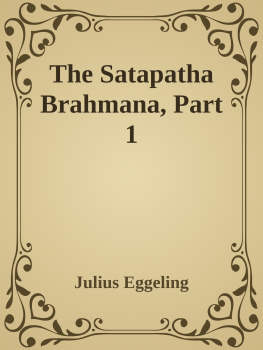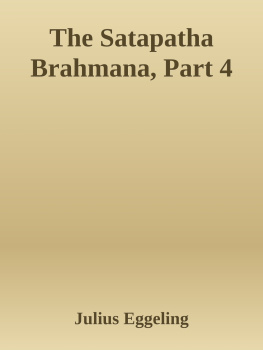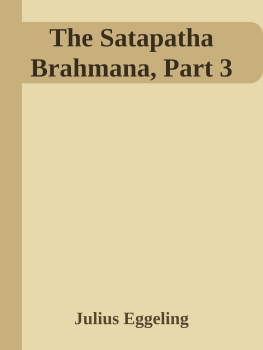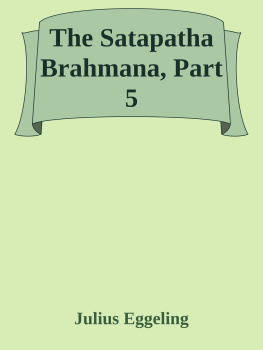Julius Eggeling - The Shatapatha Brahmana, Part 1
Here you can read online Julius Eggeling - The Shatapatha Brahmana, Part 1 full text of the book (entire story) in english for free. Download pdf and epub, get meaning, cover and reviews about this ebook. genre: Detective and thriller. Description of the work, (preface) as well as reviews are available. Best literature library LitArk.com created for fans of good reading and offers a wide selection of genres:
Romance novel
Science fiction
Adventure
Detective
Science
History
Home and family
Prose
Art
Politics
Computer
Non-fiction
Religion
Business
Children
Humor
Choose a favorite category and find really read worthwhile books. Enjoy immersion in the world of imagination, feel the emotions of the characters or learn something new for yourself, make an fascinating discovery.
- Book:The Shatapatha Brahmana, Part 1
- Author:
- Genre:
- Rating:3 / 5
- Favourites:Add to favourites
- Your mark:
- 60
- 1
- 2
- 3
- 4
- 5
The Shatapatha Brahmana, Part 1: summary, description and annotation
We offer to read an annotation, description, summary or preface (depends on what the author of the book "The Shatapatha Brahmana, Part 1" wrote himself). If you haven't found the necessary information about the book — write in the comments, we will try to find it.
The Shatapatha Brahmana, Part 1 — read online for free the complete book (whole text) full work
Below is the text of the book, divided by pages. System saving the place of the last page read, allows you to conveniently read the book "The Shatapatha Brahmana, Part 1" online for free, without having to search again every time where you left off. Put a bookmark, and you can go to the page where you finished reading at any time.
Font size:
Interval:
Bookmark:
This is part I of the Sacred Books of the East Satapatha Brahamana translation, containing Books I and II.This portion is notable for the description of thestory of the flood of Manu.
Title PageContentsIntroduction
Scanned at sacred-texts.com, June 2006. Proofed and formatted by John Bruno Hare. This text is in the public domain in the United States because it was published prior to January 1st, 1923. These files may be used for any non-commercial purpose, provided this notice of attribution is left intact in all copies.
PAGE | |
INTRODUCTION | |
| |
Darsapurnamaseshti, or New and Full-moon Sacrifices | |
Vow of Abstinence | |
Preparation of Offerings | |
Leading forth of Pranitah | |
Taking out of rice for the cakes | |
Preparation of strainers and consecration of the rice by sprinkling with lustral water | |
Husking and grinding of the rice | |
Putting on of the potsherds | |
Preparation and baking of the cakes | |
Preparation of the Altar | |
Samishtayagus, or throwing away of the grass-bush | |
Lines of enclosure | |
Cleaning of spoons | |
Girding of the sacrificer's wife and eyeing of the butter | |
The offering-spoons | |
Covering of the altar with sacrificial grass | |
Enclosing of the fire with the Paridhis | |
Kindling of the Fire | |
The Pravara, or choosing of the Divine Hotri | |
Agharau, or two libations of ghee | |
The Pravara, or choosing of Human Hotri | |
Prayagas, or fore-offerings | |
Agyabhagau, or two butter-portions to Agni-Soma | |
Special Preliminary Rites of New-moon Sacrifice | |
Chief Offerings, viz. | |
Cake to Agni. | |
Low-voiced offering (upamsuyaga) to Agni-Soma. | |
Cake to Agni-Soma at Full-moon Sacrifice. | |
Cake to Indra-Agni, or Samnayya to Indra at New-moon Sacrifice. | |
Oblation to Agni Svishtakrit | |
PAGE | |
Brahman's portions | |
Ida | |
Anuyagas, or after-offerings | |
Suktavaka, Samyuvaka, and offering of remains | |
Patnisamyagas | |
Concluding ceremonies | |
| |
Agnyadhana, or Establishment of Sacred Fires | |
Sambharas | |
Asterisms suitable for Agnyadhana | |
Seasons suitable for Agnyadhana | |
Upavasatha | |
Churning and laying down of fire | |
Oblations | |
Punaradheya, or Re-establishment of Fire | |
Agnihotra, or Morning and Evening Milk-offerings | |
Agnyupasthana, or Worship of Fires | |
Pindapitriyagna, or Oblation of Obsequial Cakes to Deceased Ancestors | |
Agrayaneshti, or Offering of First-fruits | |
Dakshayana (New and Full-moon) Sacrifice | |
Katurmasyani, or Seasonal Sacrifices | |
Vaisvadeva | |
Varunapraghasah | |
Sakamedhah | |
Mahahavih, or great oblation | |
Maha-pitriyagna | |
Oblation to Rudra Tryambaka | |
Sunasirya | |
Additions and Corrections | |
Transliteration of Oriental Alphabets adopted for the Translations of the Sacred Books of the East |
THE translator of the Satapatha-brahmana can be under no illusion as to the reception his production is likely to meet with at the hand of the general reader. In the whole range of literature few works are probably less calculated to excite the interest of any outside the very limited number of specialists, than the ancient theological writings of the Hindus, known by the name of Brahmanas. For wearisome prolixity of exposition, characterised by dogmatic assertion and a flimsy symbolism rather than by serious reasoning, these works are perhaps not equalled anywhere; unless, indeed, it be by the speculative vapourings of the Gnostics, than which, in the opinion of the learned translators of Irenus, 'nothing more absurd has probably ever been imagined by rational beings .' If I have, nevertheless, undertaken, at the request of the Editor of the present Series, what would seem to be a rather thankless task, the reason will be readily understood by those who have taken even the most cursory view of the history of the Hindu mind and institutions.
The Brahmanas, it is well known, form our chief, if not our only, source of information regarding one of the most important periods in the social and mental development of India. They represent the intellectual activity of a sacerdotal caste which, by turning to account the religious instincts of a gifted and naturally devout race, had succeeded in transforming a primitive worship of the powers of nature into a highly artificial system of sacrificial ceremonies, and was ever intent on deepening and extending its hold on the minds of the people, by surrounding its own vocation with the halo of sanctity and divine inspiration. A complicated ceremonial, requiring for its proper observance and
Font size:
Interval:
Bookmark:
Similar books «The Shatapatha Brahmana, Part 1»
Look at similar books to The Shatapatha Brahmana, Part 1. We have selected literature similar in name and meaning in the hope of providing readers with more options to find new, interesting, not yet read works.
Discussion, reviews of the book The Shatapatha Brahmana, Part 1 and just readers' own opinions. Leave your comments, write what you think about the work, its meaning or the main characters. Specify what exactly you liked and what you didn't like, and why you think so.













